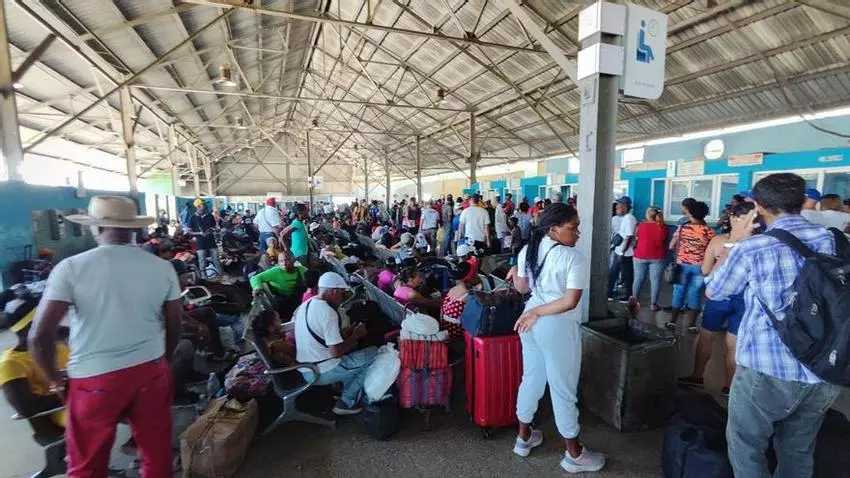Cuba’s Former Minister of Economy José Luis Rodríguez recognizes “mistakes” and the impossibility of reaching the 2% growth predicted in 2024

![]() 14ymedio, Madrid, 27 August 2024 — Cuba’s gross domestic product (GDP), which collapsed by 1.9% in 2023, will not even come close this year to the predicted 2% increase. An article published this Monday in the state media – Evaluation of the International Economy and Its Impact on Cuba – and signed by the former Minister of Economy, José Luis Rodríguez, bluntly exposes the debacle that the country is experiencing. The novelty is the recognition by an official source of the size of the disaster, although it continues with the usual propaganda mantra of the “decisive weight of the US economic blockade.”
14ymedio, Madrid, 27 August 2024 — Cuba’s gross domestic product (GDP), which collapsed by 1.9% in 2023, will not even come close this year to the predicted 2% increase. An article published this Monday in the state media – Evaluation of the International Economy and Its Impact on Cuba – and signed by the former Minister of Economy, José Luis Rodríguez, bluntly exposes the debacle that the country is experiencing. The novelty is the recognition by an official source of the size of the disaster, although it continues with the usual propaganda mantra of the “decisive weight of the US economic blockade.”
The other culprits, according to the author, are the 2020 Covid-19 pandemic, the increase in food prices worldwide – 20% above the average values of 2014-2016 – and the “international breaches of agreements that were supposed to guarantee the import of oil” – currently above 81 dollars a barrel – but also the “slow recovery in tourism,” and, what is more striking, “the consequences of mistakes made in our own management.” The result of all this, according to the economist, “is that the country suffered between 2019 and the first half of 2024 a loss of more than 4 billion dollars in external income.”
Compared to 2019 and until 2023, revenues decreased by more than 3 billion dollars. One of the most relevant items is remittances — the money sent home by Cubans abroad — the country’s second source of income behind the sale of medical services, which between 2019 and 2020 fell by 26% (to $2,348 million), “according to unofficial sources,” and in 2021 by more than 50%, to $1,084 million. “This figure does not seem to have increased in 2023, not even considering that Western Union resumed sending remittances to Cuba, which augured a greater increase,” says Rodríguez, recalling that “remittances play an important role as working capital for the non-state sector and sustain an appreciable level of consumption in the market that operates in MLC” (freely convertible currency). continue reading
One of the most relevant items is that of remittances, which have fallen to 1,084 million dollars
Citing a report reviewed by CNN in 2021, the author indicates that “26% of Cuban households received remittances, about 2% of the GDP. Some 83.7% came from the United States, and more than 60% arrived informally.” Another study that is included in the article is one from Inter-American Dialogue, which estimated money transfers to the Island in 2023 at 2.458 billion dollars, but the former minister clarifies that “there is no clear evidence that remittances grew to that level last year.”
Another “negative element” recognized by Rodríguez is the “non-compliance with payments of the external debt service,” which forced the regime in 2020 to a new renegotiation with the Paris Club – apart from the one agreed in 2015 – “achieving a postponement of the payments for that year only.” Recently, the economist indicates, “an additional deadline was established for the payment of the debt, although no more details are known.”
It also “transcended,” says the former minister — using that word — that “it was possible to postpone payments until 2040 in the case of Russia, and work is being done on the restructuring of the debt with China.” The investments of both countries, which were paralyzed “by non-payments,” says Rodríguez, were “unlocked,” and Beijing even donated 100 million dollars, thanks to the international tour carried out by President Miguel Díaz-Canel in November 2022 through Algeria, Russia, Turkey and China.
As a result of those trips, “the cancellation of interest on Cuba’s debt with Algeria and the indefinite postponement of the restart of disbursements was also achieved,” says the economist.
Beijing even donated 100 million dollars, thanks to the international tour made by Díaz-Canel in November 2022
Although Rodríguez diligently mentions the “will of Cuba to pay the external debt when economic conditions for the country improve,” he says that it is “indispensable to resume the alternative of a more flexible renegotiation of the debt.” This was estimated at the end of 2023, “according to creditors,” at about 29.4 billion dollars, “which is estimated to be equivalent to more than 40% of GDP.”
All this data leads the former minister to justify the “urgent measures,” which, however, he says, quoting Díaz-Canel diligently, “should lead us not to insist on a route that has proven to be impractical for being unsustainable.”
José Luis Rodríguez does not mention these new measures, but they are supposed to specified in the package of laws published last week in the Official Gazette, which, far from promoting flexibility in the economy, reinforce the control, prohibitions and fines for micro, small and medium-sized enterprises (MSMEs).
The official daily press is responsible for details of these provisions, a total of 19, which repeal all the previous ones referring to private companies from 2012 to 2023, and occupy 167 pages of the August 19th Gazette. This same Monday, for example, the news regarding tax changes is revealed, including the brackets that affect the self-employed, regulated by Resolution 271 of the Ministry of Finance and Prices, and which will come into force 30 days after being published on September 18.
In addition, it mentions the obligation for private businesses to have a “fiscal bank account” in a Cuban bank and declared to the ONAT
One of them is the application of a proportional scale, in which the excess of between 15,000 and 20,000 pesos will have a 7.5% tax imposed; between 20,000 and 25,000, a 10% tax; between 25,000 and 30,000, 15%; and more than 30,000, a 20% tax.
The law also empowers the municipal councils in an unprecedented way, says the official State newspaper Granma, to decide whether to reduce up to 35% the tax obligations for self-employed workers (TCP) who “carry out their activities in rural areas of difficult access or mountainous, due to the conditions in which the taxpayer carries out the activity or the need to provide a public service at low prices.” Of course, “with exceptional character.”
In addition, it emphasizes the obligation for private businesses to have a “fiscal bank account” in a Cuban bank and declared to the National Tax Administration Office (ONAT). From that account they must execute the payment of taxes and also all expenses related to “capital repairs, constructive maintenance, purchase of means and equipment, and services received from the forms of non-state management that are carried out through banking instruments.”
In the case of TCPs dedicated to fishing, four specific taxes are established, through Resolution 273: one of 5% “on personal income,” when what they receive from the marketing of the catches exceeds 3,260 pesos; another of 10% “on sales and on services,” according to “the decisions adopted in this regard by local governments,” excluding income from “deliveries to fishing companies and other authorized entities”; another of 5% “for the use of labor force” on wages to workers, and a last “special contribution to Social Security.”
The recent legal battery also contains numerous instruments to avoid “irregularities” and impose fines, something that is also emphasized by the official press on a daily basis. In a note published on Sunday, Granma boasts that the regime closed a total of 171 establishments and withdrew 197 “work projects” only in the week of August 17 to 23, for “violations detected.”
On those days there was a total of “58 confiscations and 773 forced sales”for reasons such as “marketing products without showing prices, not showing the legality of raw materials used in the provision of services, not displaying the QR codes of the gateways and for employment of personnel who work without the corresponding contract.”
The article highlights the price controls established in Resolution 225 – also mentioned in the Gazette – for six “high demand products”: chicken, oil, powdered detergent, pasta, sausages and powdered milk.
Without mentioning the dates, the authorities say that so far a total of 157,331 control actions have been carried out, in which “debits” were determined for an exorbitant total that is close to three billion pesos.
Translated by Regina Anavy
____________
COLLABORATE WITH OUR WORK: The 14ymedio team is committed to practicing serious journalism that reflects Cuba’s reality in all its depth. Thank you for joining us on this long journey. We invite you to continue supporting us by becoming a member of 14ymedio now. Together we can continue transforming journalism in Cuba.


























